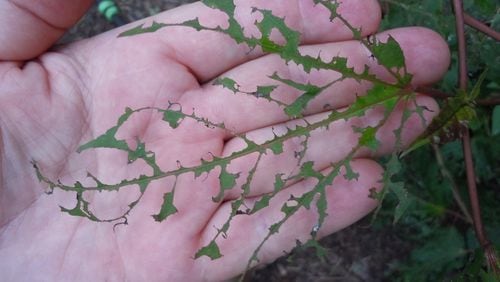Q: My hibiscus is growing beautifully but something is eating the leaves. I can't see any bugs. D. Pesce, Cobb County
A: My guess is that your hibiscus has been chewed on by hibiscus sawfly larvae. These caterpillar-like creatures feed on the bottom side of leaves so you don't notice them until holes form. The easiest way to control them is to use a systemic insecticide drench that contains imidacloprid (Bayer Tree and Shrub) in April. An organic spray that contains spinosad (Captain Jack's Dead Bug Brew) will work if you concentrate it under the leaves. You can assist nature by planting flowers that attract beneficial insects, like alyssum, catmint, and lemon balm, nearby.
Q: You recently responded to a question about wilted vegetable leaves that might be caused by weed killer. I had the same symptoms in a new garden bed I planted with top soil from a nursery. Does UGA test soil for weed killer chemicals? Jay Brantley, email
A: Your local University of Georgia Extension office (800-ASKUGA1) can test for pesticides, but only if you can first tell them which chemical, out of dozens, their machines should look for. That's impossible in most homeowner situations. Consider doing a bioassay with a bean or tomato plant before you decide to submit a sample. Directions atbit.ly/bioassay.
Q: We have a large white oak tree in our back yard. This week we noticed all the leaves are turning brown, top to bottom. Any idea what is causing this? S. B. Ray, Cartersville
A: This has been a terrible summer for white oak and red oak trees. Oaks are very sensitive to having their roots become dry, and that is probably what happened to your tree last fall. The initial damage might even have been done in the drought several years ago. It is not likely the tree will recover after losing all of its leaves but you're welcome to wait until next spring and see what happens. If you don't see many green leaves by May, the tree will have to come down.
Q: I noticed brown sap oozing from my three-year-old dwarf peach tree. An arborist told me this is caused by peach borers. I sprayed insecticide but recently I have noticed a few areas around small branches where the sap is coming out again. How do I save this tree? Roger Solomon, email
A: In my experience, peach tree borers are rarely the cause of sap coming out of a peach trunk. If you notice the sap oozing more than 12 inches from the bottom of the tree, it is almost certainly not borer damage. Typically the sap comes from a bark canker. The canker, in turn, comes from environmental or mechanical stress on the tree. Poor root growth, drought, or kids banging on the tree with a stick all could cause cankers. Be sure to mulch your tree, water during dry times, and consider sprinkling a pint of garden lime around the tree to raise the soil pH.
Q: What suggestion do you have to cover an area under our deck that is red clay but has no sunshine? What grass or ground cover could we use? Patricia Klecka, Dallas
A: All plants must have sufficient sunshine to photosynthesize. I will wager there is not enough light under your deck to support either grass or groundcover plants. Consider pine chip mulch instead.






